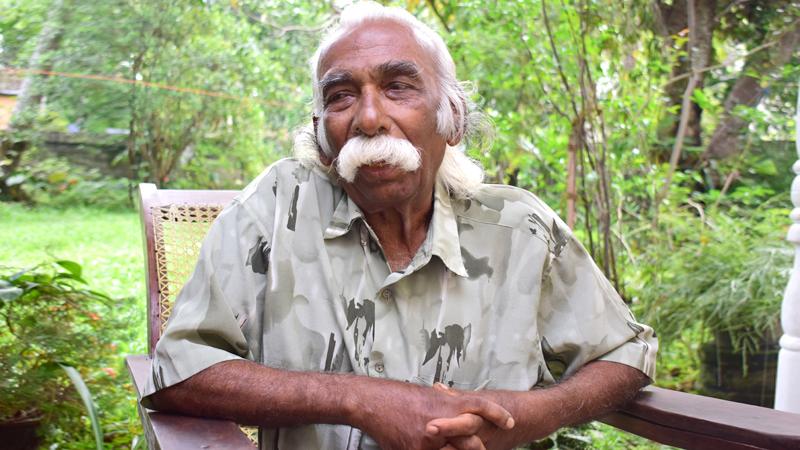
G. R. Perera, who died last Monday, hailed from the same generation as Sumitra Peries, who died last January. A towering hulk of a man, Perera often played characters who did not want to flaunt their strength, who concealed their aggressive streak. This did not make him timid, still less submissive. Whether he was playing a monk or a Mudaliyar, he knew when to be assertive and when to step back. The result was a remarkable combination of bravado and self-restraint that epitomised him. Yet such a combination served in the end to restrict him: much of the time he had to be content playing secondary roles.
It would be a mistake, however, to view this purely as a limitation. Perera may have been restricted to secondary roles, but even within these limits he gave his best and built up an impressive portfolio of performances. Not all of them ranked at the top of the league, but not all of them ranked at the bottom either: he could play the Mudaliyar (Nidhahase Piya) with as much finesse as the servant of the manor (Aswesuma), a henchman (Welikathara) with as much facility as a monk (Giraya). Like Joe Abeywickrema, the greatest character actor Sri Lanka ever seen, Perera remained, to his last, a chameleonic figure.
Early days
Chameleonic, and colourful. When I met him in 2016, he opened himself up, not caring to restrain himself. This may have been because he lived through a very colourful childhood and adolescence. Born in Kirulapone in 1939, Perera was initially educated at Rattanapitiya in Boralesgamuwa. His family moved to Egodawatte, one of the 13 villages which made up Boralesgamuwa, and sent him to Kumara Vidyalaya in Kotahena. It was at Rattanapitiya, in or around 1950, that he met and befriended Tissa Abeysekara. The two of them became good friends, cycling together to Kandy, sampling the latest films and books.
A deeply bilingual man, Perera’s tastes remained decidedly eclectic. He was at ease and at home with both Erskine Caldwell and Martin Wickramasinghe. His own career began with the theatre, specifically with Sugathapala de Silva. There are perhaps many versions of how de Silva came up with a name for his stage troupe, and Perera had his. Apparently the two of them had been brainstorming for names at the Vihara Maha Devi Park for almost two weeks and along the way several arrack bottles had been, to put it politely, downed. Exasperated and not a little frustrated, on the 12th day Perera had blurted out, “Balahan Sugath, arakku bothal daha thunak oni ne ape kattiyata namak hoyaganna!”
De Silva had paused. “Stop right there!” he had expostulated. Thinking for a while, he had smiled at Perera and declared: “Ape Kattiya we shall be!”
All this led to Perera’s debut in Dharmasiri Wickramaratne’s Ran Thodu, which apparently created such a furore and a sensation that several actors and writers joined them, including Wickrema Bogoda and Premaranjith Tilakaratne. Premaranjith, a fiery radical even during his time, subsequently broke away from Ape Kattiya and formed his own troupe, 63 Kandayama. He persuaded Perera to play a leading role in his debt, Waguru Bima, in 1963. One thing led to another again, and D. B. Nihalsinghe chose him to play a minor though important role in his debut, Welikathara. Perera’s performance there lasts for around 10 minutes: it was shot, he remembered for me, at G. D. L. Perera’s office in Nawinne.
These were formative years, particularly for the Sinhala cinema. Yet Perera did not particularly distinguish himself in film: a tally of less than 60 films, including three Indian, two American, and one German, would after all hardly constitute a “prodigious” career. Rather, it was in television that the man proved his worth and made a name for himself. Counting in more than 600 television serials and performances, Perera carved a niche for himself as a supporting actor, a feat which eventually broke records and for which he was recognised officially, when some years ago, at the Raigam Awards, he received a statuette as the actor with the highest number of television appearances.
Novel ideas
He remained, to the last, prone to talk. It was impossible to end any conversation you began with him, especially if that conversation centred on subjects closest to his heart. And there were quite a number of subjects close to his heart, among them the state of the nation’s theatre. Once, for instance, he had approached the Norwegian Ambassador and proposed a novel idea. “I wanted Sri Lanka to have more complexes outside Colombo. These would be named after playwrights from the world over and financed by the citizens of their countries. Norwegians, for instance, could help build a complex named after Ibsen.” Sadly, though the Ambassador had been intrigued, the project never came to be.
Truly talented
Such passions and obsessions dotted Perera’s life, even though people would not normally associate him with them. For them, as for most of us, Perera remained an actor, a pretty decent one. Although much can be said and written about the quality of the productions that he took part in – from the high point of Sri Lankan cinema and television in the 1970s and 1980s, we have slipped, badly – it goes without saying that, despite the limits within which he had to perform, he performed well. Perhaps the best example for this would be one of his last roles, as Mudaliyar Senanayake in Nidahase Piya.
That film left much to be desired, artistically and historically, but as the paterfamilias of the Senanayake family, Perera reimagined his role, embodying him, but also individualising him. In the end that became his signature: his ability at assimilating his role, and giving it his own distinct flavour.
The writer is an international relations analyst, researcher, and columnist who can be reached at [email protected]
